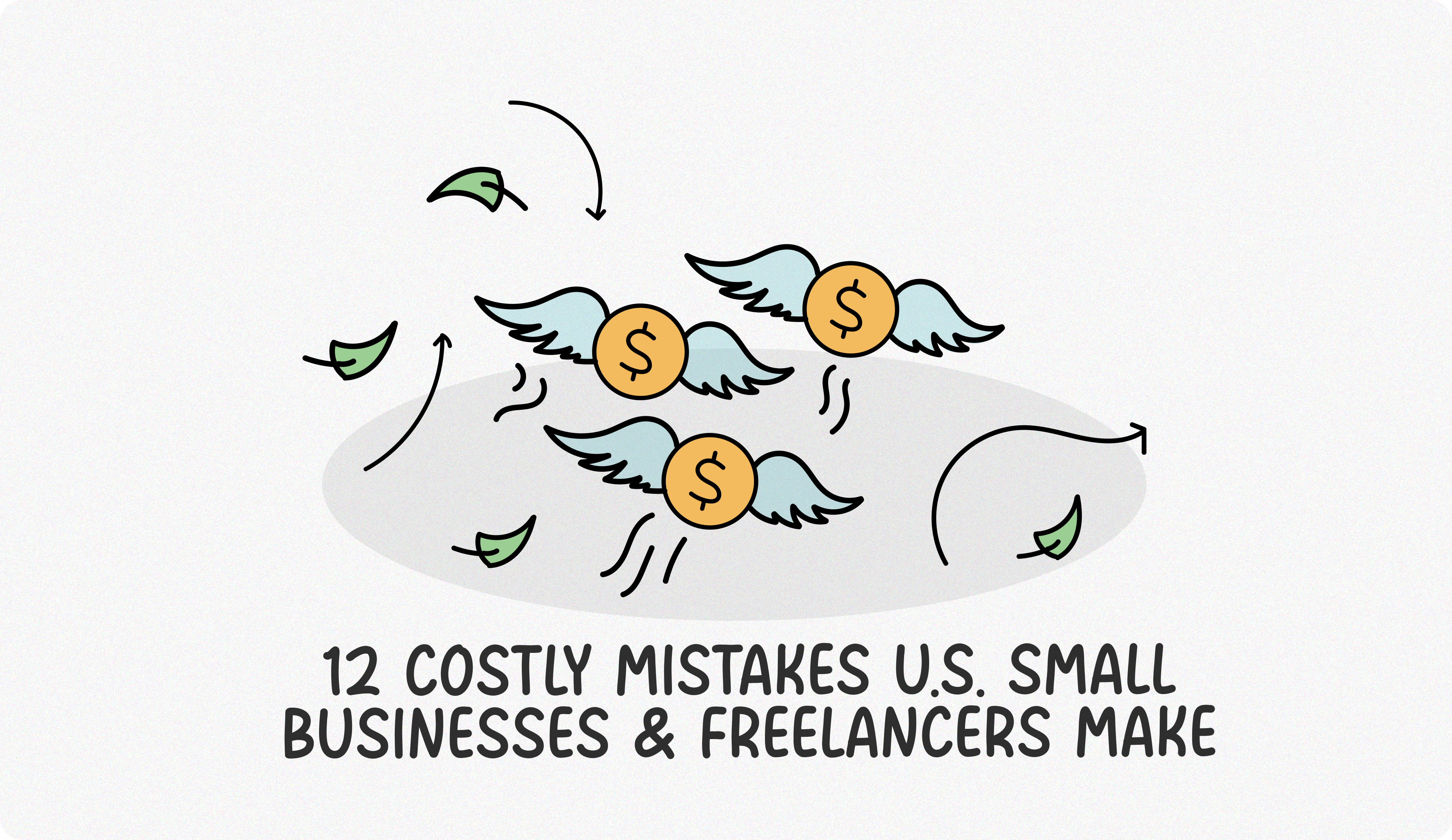Running your own business comes with freedom, creativity, and pride. But it also comes with rules — thousands of them. And if you break those rules, even by accident, you can get slapped with fines that derail your finances.
The numbers show how high the stakes can be. In fiscal year 2022, the IRS assessed $73.6 billion in civil penalties, and compliance missteps remain one of the biggest obstacles for entrepreneurs. According to the MetLife & U.S. Chamber of Commerce Small Business Index (Q4 2024), 51% of small businesses reported that regulatory requirements are actively hindering their growth. And when you’re already juggling sales, clients, and payroll, the last thing you need is a surprise bill from the government.
The good news? Most of these fines are avoidable once you know where the landmines are. Here’s a breakdown of 12 common small business fines, what they cost, and how to protect your business from these costly mistakes.
Table of Contents
- 1. Late-Filing Penalty (Income Tax)
- 2. Underpayment Penalty (Estimated Taxes)
- 3. Misclassification Fine
- 4. Forgotten 1099-NEC Penalty
- 5. OSHA Workplace Safety Fine
- 6. ADA Website Accessibility Fine
- 7. Data Privacy Violation Fine
- 8. Unpaid Sales Tax Fine
- 9. Trademark/Copyright Infringement Fine
- 10. Unlicensed Business Fine
- 11. Unpaid Wage and Overtime Fine
- 12. Payroll Tax Fine
- Final Takeaway: A Little Prevention Goes a Long Way
1. Late-Filing Penalty (Income Tax)
This is one of the most common pitfalls for new entrepreneurs. Missing the deadline to file your business or personal tax return can trigger a significant penalty from the IRS. The penalty is typically 5% of the unpaid taxes for each month or part of a month that the return is late, with a maximum cap of 25%.
How to Avoid It:
- Know Your Deadlines
Be aware of key dates, whether it’s the April 15th deadline for your personal return (Form 1040) or a different date for your business entity. Mark these on your calendar and set a reminder well in advance.
- File for an Extension
If you need more time to file, you can submit an extension request to the IRS (Form 4868 for individuals). Remember, this extends the time to file your return, but not the time to pay any taxes you may owe.
- Maintain Organized Records
Keeping your financial documents—from income statements to expense receipts—organized throughout the year will make tax preparation smoother and less stressful. ting.
2. Underpayment Penalty (Estimated Taxes)
As a freelancer or sole proprietor, you are required to pay income and self-employment taxes in four quarterly installments throughout the year. If you don’t pay enough by the due date for each quarter, the IRS can impose an underpayment penalty. This often catches new business owners by surprise, as they may assume they can simply pay their entire tax bill in April.
How to Avoid It:
- Calculate and Pay Quarterly
Accurately estimate your income and expenses for the year and divide your tax liability into four equal payments. To avoid a penalty, you generally need to pay at least 90% of your current year’s tax liability or 100% of your previous year’s tax liability.
- Utilize Accounting Software
A reliable accounting solution can help you track income and expenses in real-time, making it significantly easier to estimate your tax payments and ensure you’re setting aside enough money each quarter.
For a detailed breakdown of deadlines and calculations, read our blog: The Freelancer’s Guide to the 2025 Self-Employed Quarterly Tax Schedule.
3. Misclassification Fine
Misclassifying a worker as an independent contractor when they should be an employee is a major red flag for both the IRS and the Department of Labor (DOL). While using contractors can be more flexible for your business, the government has strict rules. If they determine you’ve misclassified a worker, you could face severe fines and be required to pay back taxes, interest, and other penalties. Some states impose fines of tens of thousands of dollars per misclassified worker.
How to Avoid It:
- Understand the IRS Tests
The IRS historically used a 20-factor test, but today it emphasizes the broader “right-to-control” framework, which looks at three areas: behavioral control (who directs the work), financial control (who controls business aspects of the job), and the relationship of the parties (contracts, benefits, permanency, etc.).
- Check State Laws Too
Some states apply stricter standards—like the “ABC test,” which presumes workers are employees unless the business can prove all three conditions are met:- A: The worker is free from the company’s control and direction in performing the work.
- B: The work performed is outside the usual course of the company’s business.
- C: The worker is engaged in an independently established trade, occupation, or business.
Failing any of these means the worker is considered an employee. Don’t assume federal rules are the only ones that matter.
- Document the Relationship
Always have a clear, written agreement with every independent contractor that outlines the scope of work and clearly defines their independent status.
4. Forgotten 1099-NEC Penalty
If you pay a contractor $600 or more in a single tax year, you are required to file a Form 1099-NEC with the IRS and provide a copy to the contractor. Many small business owners overlook this crucial step. The fines for late or incorrect filing can be steep, ranging from $60 to $330 per form, with a penalty of $660 per form for intentional disregard. The deadline is typically January 31st.
How to Avoid It:
- Stay Organized from the Start
As soon as you hire a new contractor, obtain a completed Form W-9 from them. This form provides all the necessary information for filing their 1099-NEC.
- Automate the Process
Use a system that tracks your payments to contractors. Many accounting and payroll software platforms can automate the generation and filing of 1099s, making it a simple, hassle-free process.
5. OSHA Workplace Safety Fine
Even if you run a small office or a creative studio, you are legally required to provide a safe working environment for your employees. The Occupational Safety and Health Administration (OSHA) can inspect your premises and issue fines for violations. For 2024, the penalty for a “serious” violation can be up to $16,550 per violation, while a “willful” or “repeated” violation can reach a maximum of $165,514. Don’t think you’re too small to be noticed; many businesses are fined for common oversights like failing to have a clear exit path or not providing basic safety equipment.
How to Avoid It:
- Conduct Regular Inspections
Periodically walk through your workspace to identify and address potential hazards. Are fire extinguishers easily accessible? Is the floor clear of tripping hazards?
- Post Required Information
Ensure you display the required OSHA poster in a visible location for all employees. This simple step is a common compliance check for inspectors.
6. ADA Website Accessibility Fine
In today’s digital world, your website is considered a “public accommodation” under the Americans with Disabilities Act (ADA). This means it should be accessible to people with disabilities who rely on screen readers, keyboard navigation, or other assistive technologies.
The ADA doesn’t publish a fixed fine schedule for websites. Instead, enforcement usually happens through lawsuits or settlements. These cases can be costly—legal fees and settlements often run into the tens of thousands of dollars, and in some cases much higher. The Department of Justice can also impose civil penalties, which currently range up to $75,000 for a first violation and $150,000 for subsequent violations—but in practice, the real financial impact often comes from litigation costs.
How to Avoid It:
- Audit Your Website
Use free or professional tools to audit your website’s accessibility. Look for issues like missing “alt text” on images, poor color contrast, or navigation that can’t be used with a keyboard alone.
- Follow WCAG Guidelines
Adhering to the Web Content Accessibility Guidelines (WCAG) is the gold standard for ensuring your site is compliant and user-friendly for everyone.
7. Data Privacy Violation Fine
If your business collects any customer data—even just names and email addresses—you have a legal responsibility to protect it. With new laws like California’s CCPA, fines for data breaches or mishandling can be astronomical. Violations can range from tens of thousands of dollars to much more, depending on the severity and number of people affected.
How to Avoid It:
- Use Secure Platforms
Utilize reputable, secure software for your website, payment processing, and customer relationship management.
- Draft a Privacy Policy: Have a clear and easy-to-read privacy policy on your website that explains what data you collect and how you use it.
- Stay Informed
Keep an eye on evolving data privacy laws at both the federal and state levels.
8. Unpaid Sales Tax Fine
For businesses that sell physical goods (or certain taxable services), collecting and remitting sales tax is legally required. Many small businesses run into trouble because they’re unaware of their state’s nexus laws—the thresholds or connections (sales volume, number of transactions, physical presence) that trigger sales tax obligations.
Penalties and interest for late or unpaid sales tax vary widely by state and situation. In typical cases, fines might be 10–30% of the tax owed, plus interest. But in more serious cases—such as fraud, willful evasion, or repeat violations—some states may impose penalties ranging up to 50% or more of the unpaid tax.
How to Avoid It:
- Register in Each State
If your business has a physical presence or reaches a certain level of sales in a state, you must register there to collect sales tax.
- Automate with Software
E-commerce platforms and accounting software can automate sales tax calculations and reporting, ensuring you charge the correct rate and file on time.
9. Trademark/Copyright Infringement Fine
Using a protected logo, image, song, or slogan without permission can quickly turn into a legal nightmare. Many small business owners run into this problem by pulling images or music from the internet, assuming they’re “free to use.” In reality, infringement lawsuits are often far more expensive than simply licensing the material.
- Copyright: Statutory damages can range from $750 to $30,000 per work, and up to $150,000 per work if the infringement is willful.
- Trademark: Under the Lanham Act, damages can include actual losses, infringer’s profits, and in cases of willful infringement, damages may be tripled plus attorney’s fees.
How to Avoid It:
- Use Royalty-Free Content: Stick to stock photography and music from reputable sites that provide the necessary licenses.
- Check for Trademarks: Use the U.S. Patent and Trademark Office database to ensure your business name, logo, or slogan isn’t already in use.
- Get Permissions in Writing: If you want to use someone else’s work, secure a proper license or written authorization.
10. Unlicensed Business Fine
Depending on your industry and location, you may need a specific business license to operate legally. This can be anything from a home-based business license to a professional license for a service provider. Operating without the necessary license can result in fines from city, county, or state authorities.
How to Avoid It:
- Conduct Thorough Research: Before you launch your business, check your local government’s website to see what licenses are required for your specific business type.
- Renew on Time: Many licenses expire annually, so set a reminder to renew them well before the deadline to avoid a lapse in compliance.
11. Unpaid Wage and Overtime Fine
The Fair Labor Standards Act (FLSA) requires employers to pay minimum wage and overtime for all hours worked over 40 in a workweek. Even if a salaried employee is paid, they may still be eligible for overtime pay. Failing to comply can result in fines and a requirement to pay back wages, which can be a significant financial burden for any business.
How to Avoid It:
- Know Your Laws
Understand the difference between exempt and non-exempt employees and the specific overtime rules that apply in your state.
- Ensure Accurate Timekeeping
Use a reliable time-tracking system to ensure all hours, including overtime, are accurately recorded and paid.
12. Payroll Tax Fine
If you have employees, you’re responsible for withholding federal and state income taxes, as well as Social Security and Medicare taxes, from their paychecks. These withheld taxes must then be remitted to the government on time. Failing to do this correctly can lead to a Trust Fund Recovery Penalty, which holds you personally liable for the unpaid taxes, not just your business.
How to Avoid It:
- Use Payroll Software
This is a crucial area where automation is a lifesaver. Payroll software automates the withholding and remittance process, ensuring you stay compliant with all federal and state requirements.
- Keep Funds Separate
The money you withhold from employees is not your business’s money; it belongs to the government. Never use it for other business expenses, no matter the temptation.
Tax laws, penalties, and fine amounts are adjusted regularly (often annually for inflation). Always confirm the latest figures and requirements directly from official sources such as the IRS, U.S. Department of Labor, OSHA, and your state’s Department of Revenue before making compliance decisions.
The Final Takeaway: A Little Prevention Goes a Long Way
Fines are painful, but avoidable. By knowing what triggers them, what they cost, and how to stay compliant, you protect not just your finances but your reputation and customer trust.
And you don’t have to track all this alone. Fynlo makes compliance easier by helping freelancers and small business owners stay on top of bookkeeping, tax deadlines, and reporting. With smarter tools, you can focus less on paperwork and more on building your business.
Ready to take the stress out of compliance? Book a quick call with Fynlo and see how our tools can help you stay penalty-free and focused on growing your business.
You may also like these articles:







